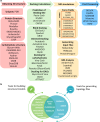Computational toolbox for the analysis of protein-glycan interactions
- PMID: 39189002
- PMCID: PMC11346309
- DOI: 10.3762/bjoc.20.180
Computational toolbox for the analysis of protein-glycan interactions
Abstract
Protein-glycan interactions play pivotal roles in numerous biological processes, ranging from cellular recognition to immune response modulation. Understanding the intricate details of these interactions is crucial for deciphering the molecular mechanisms underlying various physiological and pathological conditions. Computational techniques have emerged as powerful tools that can help in drawing, building and visualising complex biomolecules and provide insights into their dynamic behaviour at atomic and molecular levels. This review provides an overview of the main computational tools useful for studying biomolecular systems, particularly glycans, both in free state and in complex with proteins, also with reference to the principles, methodologies, and applications of all-atom molecular dynamics simulations. Herein, we focused on the programs that are generally employed for preparing protein and glycan input files to execute molecular dynamics simulations and analyse the corresponding results. The presented computational toolbox represents a valuable resource for researchers studying protein-glycan interactions and incorporates advanced computational methods for building, visualising and predicting protein/glycan structures, modelling protein-ligand complexes, and analyse MD outcomes. Moreover, selected case studies have been reported to highlight the importance of computational tools in studying protein-glycan systems, revealing the capability of these tools to provide valuable insights into the binding kinetics, energetics, and structural determinants that govern specific molecular interactions.
Keywords: MD; computational tools; glycan–protein interactions; molecular recognition.
Copyright © 2024, Nieto-Fabregat et al.
Figures





References
-
- Varki A, Kornfeld S. In: Cummings R D, Esko J D, Stanley P, et al., editors. New York, NY, USA: Cold Spring Harbor; 2022. pp. 61–91.
Publication types
LinkOut - more resources
Full Text Sources
